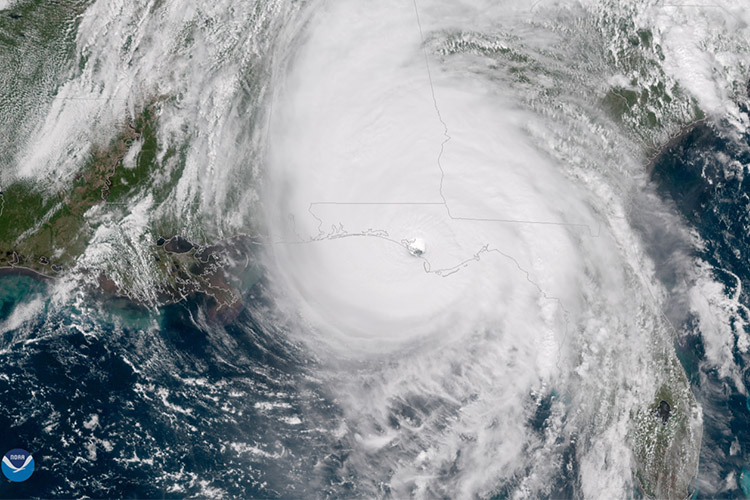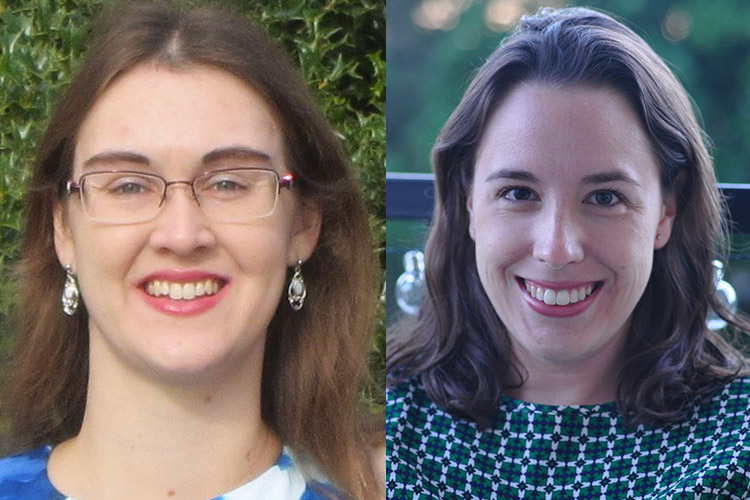FSU researchers confirm utility of theory in predicting tropical cyclone intensities

Category 5 storm Hurricane Michael is seen via satellite during landfall over the Florida Panhandle on Oct. 18, 2018. Photo courtesy the
National Oceanic and Atmospheric Administration.
Researchers from Florida State University have uncovered new information on what controls year-to-year variability in tropical cyclone intensity by evaluating a physical theory in every global ocean basin in which tropical cyclones occur.
Florida State University Department of Earth, Ocean and Atmospheric Science master of science graduate Shannon Shields and assistant professor Allison Wing studied the year-to-year variability in tropical cyclone intensity through evaluation of the tropical cyclone intensity theory. Their work, “A Global Analysis of Interannual Variability in Potential and Actual Tropical Cyclone Intensities,” was published in the American Geophysical Union’s Geophysical Research Letters last fall.
“Our research examines the correlation between interannual variability of potential intensity, which is the maximum possible intensity a tropical cyclone can reach or the theoretical “speed limit” of tropical cyclone intensity, and the actual intensity of tropical cyclones across all global ocean basins,” Wing said. “This study also focuses on the factors contributing to this variability via sea surface, upper tropospheric and lower stratospheric temperatures.”
Three major findings were uncovered while comparing these factors. The first, a correlation between year-to-year intensities of typhoons in the Western North Pacific and potential intensity, became apparent and confirmed the theory’s utility for studying storms in that region. It was a surprise that the Western North Pacific was the only basin that yielded consistently significant correlations, as prior work had also identified a correlation in the North Atlantic.
Shields and Wing realized the apparent contradiction with prior work occurred because significant correlations are only found in the North Atlantic when analyzing more than 50 years of data. This indicates that potential intensity theory can help researchers understand changes in tropical cyclone intensity over long time periods, such as changes over decades, and that factors not included in the theory, such as vertical wind shear and ocean-atmosphere interaction, should be considered in the variability of actual tropical cyclone intensity on shorter time scales.
Second, the researchers found that both warm sea-surface temperatures and cold lower stratospheric temperatures influence the year-to-year variability of theoretical tropical cyclone speed limits. Finally, evidence suggests that correlations between actual intensities and potential intensities are sensitive to the time scale of the variability considered and improve over longer time periods.
“The findings of our research are important because they help us interpret the tropical cyclone intensity theory, improve understanding of variability in tropical cyclone intensity on multiple time scales, and may even prompt further research on this topic,” Wing said.

Department of Earth, Ocean and Atmospheric Science graduate Shannon Shields and assistant professor Allison Wing. Courtesy photos.
The research was conducted using reanalysis datasets to calculate theoretical speed limits of tropical cyclone intensity, which was then compared to actual tropical cyclone intensity variability on interannual time scales. Reanalysis datasets use a weather forecast model to collect and combine available observations from sources such as weather balloons, satellites, and ground-based observation stations to generate a consistent and complete estimate of atmospheric variables.
“Even at the start of my graduate career at FSU, one of my goals was to learn more about tropical cyclones,” Shields said. “Studying severe storms and tornadoes during undergrad at the University of Oklahoma inspired me to pursue another area of atmospheric science. After working with Dr. Wing as her teaching assistant, we discussed her previous research.”
Wing, who has studied variability in tropical cyclone intensities for over a decade, published her first research on the topic in 2007. This recent work builds upon prior research by analyzing global ocean basins instead of just a few regions.
“Expanding on my previous research was something I wanted to follow up on and had been discussing with my collaborator, Daniel Gilford,” Wing said. “It was a great pleasure to work with a graduate student who was interested and able to do the research. Shannon’s level of intellect, work ethic, dedication and technical skill were impressive. I am so proud of the work she accomplished.”
Shields, who now works as a support scientist for the model evaluation group in the National Oceanic and Atmospheric Administration/National Weather Service Environmental Modeling Center, finished most of her thesis research in just a few months while also completing classes and working as a full-time teaching assistant. Because this project involved substantial analysis of multiple datasets and several versions of each calculation, Shields created over a thousand data plots.
“In addition to having my first paper published, this experience has impacted my career and research opportunities because I now have a better understanding of statistical interpretation and improved scientific writing skills, which I use in my current position,” Shields said.
Rutgers University postdoctoral associate Daniel M. Gilford also contributed to this research. The study was supported by funds from the NOAA Climate Program Office, NASA and the National Science Foundation.

